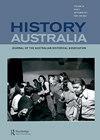菲利普·迪尔讲述澳大利亚的秘密冷战及其受害者
IF 0.4
Q3 Arts and Humanities
引用次数: 0
摘要
2020年8月,澳大利亚安全情报组织(ASIO)打破了通常保密的协议,开设了一个推特账户。该组织现在使用#ASIOhistory和#tradecraftTuesday等标签,分享自冷战初期成立以来的图像、物品和故事。通过这样做,它试图表明“虽然技术自20世纪50年代以来不断发展,但我们保护澳大利亚的使命……从#恐怖主义和#间谍活动中没有。与他们在社交媒体上展示的“聪明起来”的噱头相反,菲利普·迪尔令人印象深刻的新书《间谍与麻雀》揭示了一个组织的最初使命——在澳大利亚打击间谍和“颠覆”活动——在其成立的头三十年里被大大超越了。他强调了特工和他们的目标所付出的代价。Deery是一位研究冷战的杰出历史学家,尤其是研究冷战阴影下的地下世界。间谍与麻雀遵循了他在2014年出版的《红苹果:冷战时期纽约的共产主义与麦卡锡主义》一书中使用的公式,即对经常被忽视的个人进行传记研究,以讲述一个更大的故事。早期的那一卷集中在美国20世纪40年代末和50年代的“红色恐慌”,由约瑟夫·麦卡锡和他的众议院非美活动委员会发酵。麦卡锡虽然不是一个间谍机构,但他的权力范围很广,他对一些被认为怀有叛国思想的人造成了巨大的伤害。事业终结,名誉受损,生命丧失。澳大利亚麦卡锡主义的影响反映在禁止共产党的失败尝试和1949年(由工党政府)成立的ASIO上。被截获的代号为维罗纳的苏联电报显示,澳大利亚对西方联盟构成了“安全威胁”,而这个以英国军情六处为蓝本的间谍机构意在向美国保证堪培拉的可靠性。在成立之初,ASIO的主要职责是发现一个由澳大利亚共产党成员沃利·克莱顿领导的间谍网,迪尔认为这个间谍网更像是“一个由大约10个联系人组成的非正式组织”,而不是一个紧密联系的间谍惊悚阴谋集团(6)。迪尔的书中详细描述了ASIO如何“对少数几个……从事间谍活动的秘密共产党员和成千上万的共产党员和同路人站在贫民和被剥夺财产的一方;他们既没有意识到间谍活动,也不会批准它。本文章由计算机程序翻译,如有差异,请以英文原文为准。
Phillip Deery on Australia’s secret Cold War, and its victims
In August 2020, the Australian Security Intelligence Organisation (ASIO) broke with its normally secretive protocols and launched a Twitter account. Using hashtags like #ASIOhistory and #tradecraftTuesday, the organisation now shares images, objects and stories going back to its foundation in the early Cold War. In so doing, it seeks to show that ‘while technology’s [sic] evolved since the 1950s, our mission to protect Australia... from #terrorism and #espionage hasn’t’. Contrary to the Get Smart schtick they present on social media, Phillip Deery’s impressive new volume Spies and Sparrows reveals an organisation whose original mission – to counter espionage and ‘subversive’ activities in Australia – was dramatically overstepped throughout its first three decades. He spotlights the toll it took, on agents and those they targeted. Deery is an eminent historian of the Cold War – and particularly of its shadowy underworld. Spies and Sparrows follows a formula utilised in his 2014 volume, Red Apple: Communism and McCarthyism in Cold War New York, whereby biographical studies of often-overlooked individuals serve to tell a larger story. That earlier volume focused on the ‘red scare’ of the late 1940s and 1950s in America, fermented by Joseph McCarthy and his House Un-American Activities Committee. While not a spy agency, McCarthy’s powers were wide, and the damage he did to a range of people believed to be harbouring treasonous thoughts was significant. Careers were ended, reputations shattered and lives lost. Australia’s McCarthyite reverberations were reflected in a failed bid to ban the Communist Party, and the establishment (by a Labor government) of ASIO in 1949. Intercepted Soviet cables – codenamed Verona – revealed that Australia was a ‘security risk’ to the Western alliance, and the spy agency – modelled on Britain’s MI6 – was meant to reassure the United States of Canberra’s reliability. ASIO’s key responsibility at its inception was the identification of a spy ring led by Communist Party of Australia member Wally Clayton, which Deery classes as more ‘an informal grouping of about ten contacts’ than the close-knit cabal of spy-thrillers (6). The meat of Deery’s book details how ASIO ‘made little meaningful distinction between the handful of... covert communists who engaged in espionage activity and the thousands of CPA members and fellow travellers who... sided with the underprivileged and the dispossessed; and who were neither aware of espionage nor would have sanctioned it’ (7).
求助全文
通过发布文献求助,成功后即可免费获取论文全文。
去求助
来源期刊

History Australia
Arts and Humanities-History
CiteScore
0.60
自引率
0.00%
发文量
103
期刊介绍:
History Australia is the official journal of the Australian Historical Association. It publishes high quality and innovative scholarship in any field of history. Its goal is to reflect the breadth and vibrancy of the historical community in Australia and further afield.
 求助内容:
求助内容: 应助结果提醒方式:
应助结果提醒方式:


